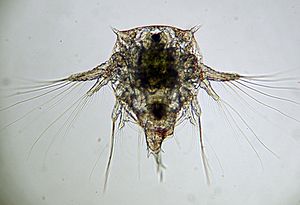Austrominius modestus facts for kids
Quick facts for kids Austrominius modestus |
|
|---|---|
 |
|
| Austrominius modestus and Semibalanus balanoides | |
| Scientific classification | |
| Genus: |
Austrominius
|
| Species: |
modestus
|
| Synonyms | |
|
Elminius modestus Darwin, 1854 |
|
The Austrominius modestus barnacle, also known as Elminius modestus, is a small sea creature. It belongs to the family called Austrobalanidae. This barnacle is originally from Australia, Tasmania, and New Zealand. But over time, it has spread to Britain and the north-west coasts of Europe. It can grow to be about 10 millimeters (about 0.4 inches) wide.
What Does the Barnacle Look Like?
A. modestus is a pearly grey color. It is also a bit see-through. This barnacle has four main shell plates. It often leans a little to one side.
Where Does This Barnacle Live?
A. modestus first came from Australia. It was first seen in British waters in Chichester Harbour during the Second World War. Scientists believe it traveled on the bottom of ships (called hulls). It might also have traveled as tiny larvae in water collected inside ships (called bilge water).
This barnacle is now very common in southern England and Wales. It is slowly spreading northwards. However, very cold sea temperatures might stop it from spreading too far north. You can find it on the upper middle part of the seashore. It can also live in places where fresh water mixes with sea water. This barnacle avoids very rough or exposed areas. By 1960, it had reached the Scottish Borders. By 1978, it was found as far north as Shetland. It also lives along the Atlantic coasts of Europe, from Gibraltar to Germany.
How Does This Barnacle Live?
A. modestus is a "suspension feeder." This means it eats tiny bits of food floating in the water. It has special feathery parts. These parts beat in a rhythm to pull plankton and other small food particles into its shell.
Female barnacles lay eggs. These eggs grow into tiny larvae called nauplius larvae. These larvae are then released into the water. They float around with other tiny plants and animals (the phytoplankton). After a while, they change into another type of larva called a cyprid larva. These cyprid larvae then find a hard surface, like a rock. They attach themselves to it and grow into adult barnacles.
In Britain, A. modestus often competes for space with another barnacle called Semibalanus balanoides. In southern Europe, it also competes with Chthamalus barnacles. A. modestus is very successful because it grows quickly. It can also handle water that is not very salty. It can live in colder temperatures than Chthamalus barnacles. It can also live in warmer temperatures than Balanus barnacles.
This barnacle is also a threat to native species. This is because it can have babies in its first year of life. It can also produce several groups of larvae each year. It can live in many different places. It grows both high up on the shore and in the shallow parts of the ocean near the coast.


